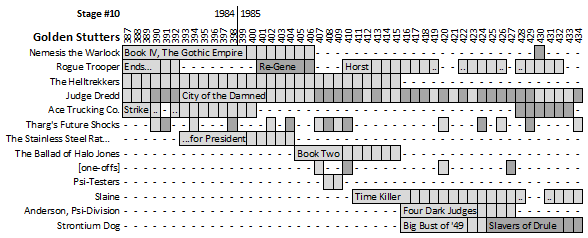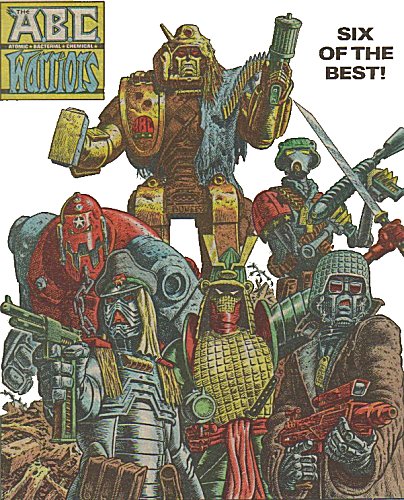Stage 10 - Golden Stutters
Progs 387-434: 1984-1985
 |
 |
 |
| Prog 399 by Bryan Talbot | Prog 406 by Ian Gibson | Prog 426 by Cam Kennedy |
Whilst there are still very powerful thrills, some of the longer-running strips are showing signs of age.
Key for this stage is a lack of new properties, with everything being either a sequel or a spin-off. Interestingly, this is the first phase where that's true. That's okay if all your existing properties are fantastic, but it perhaps signals a lack of freshness.
Tharg does have a full old chest of delights, but in that there is hidden danger that it can stifle invention. There's some glorious stuff here all the same.

Nemesis the Warlock
Originally planned as the first part before some back-filling that became the first three series, this is Book IV: The Gothic Empire. Something of a tour de force, it sets up a fantastic alien empire of shape-shifters that Torquemada (more demonic ghost than man) is hell bent on destroying.
That plot (itself riffing on Victorian horror stories such as The Murders in the Rue Morgue and Frankenstein) is busy and fantastic enough, but Pat Mills also decided to build on the idea that Termight is the future earth of Ro-Busters (as the previous book featured Mek-Quake) by reintroducing first Ro-Jaws and then a war-weary Hammerstein.
There follows a side-quest of getting the gang back together as Nemesis reforms the ABC Warriors and reveals himself to be a shared embodiment of Deadlock. The Warriors (having lost The Mess to Big George on Mars, and Happy Shrapnel in a verbal aside) now consist of Hammerstein (with what's since become his trademark metal-fatigued head), Ro-Jaws, Blackblood, a re-designed Joe Pineapples, Mongrel, Hitaki (a samurai-bot) and Mad Ronn.
This mash-up of two great properties is celebrated in the prog with a series of five Fact Files and prog 410 has the Six of the Best poster (by Brian Talbot):

Book V is in the next stage...
Rogue Trooper
To the Ends of Nu Earth closes out the main plot (of Rogue seeking revenge against the traitor general). There follows an eight-prog gap (the longest since the story launched back in prog 228) before Rogue loses his rogue-ness by returning to base and Gunnar, Bagman & Helm are re-gened in the sequence running from progs 401-406. The problem here is that all the key elements of the story have been systematically removed or resolved and so it's the end. But it doesn't end.
I remember Rogue being a regular fixture, but I had no idea that he was in the prog on such a consistent basis for so long…
The re-gened Gunnar, Bagman & Helm start to magically dissolve but the only cure is to be found on another war-torn planet and Rogue is told he's not allowed to go there ... so he goes ... rogue! This launches the Horst sequence, but the storytelling problem is twofold: the traitor general throughline was much more compelling than this new "seek a cure" and (much more importantly) Nu Earth was a key character in the story and now it's gone as well. Horst also suffers a bit from a monster-of-the-week syndrome that smacks of a poorly thought-out D&D adventure. It was always a stretch that almost everyone was appropriately named, but now we have to face up to the idea that you can't have Rogue be Rogue without him going rogue all the time.
Returns briefly in the next stage as the comic struggles to know what to do with one of it's strongest properties.
The Helltrekkers *SPIN-OFF*
Inspired by stories of wagon trains making the dangerous trek from east to west across the US, this has Mega-City One citizens attempting the same thing across The Cursed Earth in radwagons. It plays like a disaster movie, with us being introduced to folk who are then killed off by various terrible events (like dinosaur attacks and acid rain).
Although this never sparked a sequel (and was Marmite for the readership), the concept of Helltreks and radwagons became part of Dreddverse lore.
Judge Dredd
Kicking off this phase is the doubts trilogy (Question of Judgement, Error of Judgement and A Case for Treatment) in which Dredd questions his ability to provide justice. The Wally Squad, The Hunters Club and Nosferatu set up important lore for the Dreddverse. Sunday Night Fever feels like a sequel to The Graveyard Shift and Midnight Surfer sees the return of Marlon Chopper Shakespeare (who has given up scrawling for the visceral thrills of sky-surfing). We also get the mini-epic City of the Damned, which explores a possible future in which a mutated Owen Krysler clone seeks vengeance on the city (and Dredd ends up with bionic eyes, which becomes key to deciphering a later mystery).
To an extent treading comfortable water in the next stage...
Ace Trucking Co.
Captain Evil Blood drags us through the interminable thirteen-part Strike. A 27-prog hiatus is followed up with The Croakside Trip, in which Ace Garp commits suicide rather than face a terminal illness. It's worth noting that the writers have tried incarceration and now suicide as methods of avoiding writing any more of this strip.
Despite having died, Ace Garp returns in prog 451.
Tharg's Future Shocks
Peter Milligan produces twelve of the fifteen Shocks in this phase, with Alan Hebden providing the remainder.
More in the next stage...
The Stainless Steel Rat for President
Jim diGriz was last seen in prog 177 (in 1980). This is a serialization of the fifth published Rat novel by Harry Harrison.
Whilst this is the last adaptation in the prog, there are another nine books. So, there's still time, Tharg.
The Ballad of Halo Jones: Book Two
The second book follows Halo into space as a worker aboard the Clara Pandy. Although she's managed to escape The Hoop, unresolved issues from the past stalk her, and her good-hearted nature foreshadow difficulties to come.
Returns next stage for Book Three...
[one-offs]
Bad Vibrations, The Snikker Snack, Breathless and Judge Grexnix (featuring Tharg).
More one-offs in the next stage...
Psi-Testers
A psychic is blackmailed into helping a criminal. Wait: isn't that the plot of Wolfie Smith?
A (two-part) one and done extended Future Shock style story.
Slaine: Time Killer
Slaine changes quite dramatically in Time Killer. The Drune lords (evil druids) are augmented with dark gods The Cythrons: an alien race who live off negative emotions, but are restricted by rules of cosmic balance. Into that mix Slaine's axe is replaced by a leyser sword and leyser pistol: and the world we're adventuring in now feels quite different. Despite these jarring alterations, the amazing art and the inventiveness of the narrative allow it to work.
Returns next stage with Tomb of Terror...
Anderson, Psi-Division: Four Dark Judges *SPIN-OFF*
Anderson's first standalone series sees her go up against the Four Dark Judges, who we thought defeated in 1981's Judge Death Lives.
Anderson returns in prog 468's The Possessed.
Strontium Dog
The Big Bust of '49 and The Slavers of Drule are both rather derivative, and perhaps signal why such significant changes were to come. In particular, the Big Bust feels like a repeat of themes already explored well in The Bad Boys Bust ('81) and The Killing ('84).
Returns next stage with the seminal The Ragnarok Job.
Extras:

